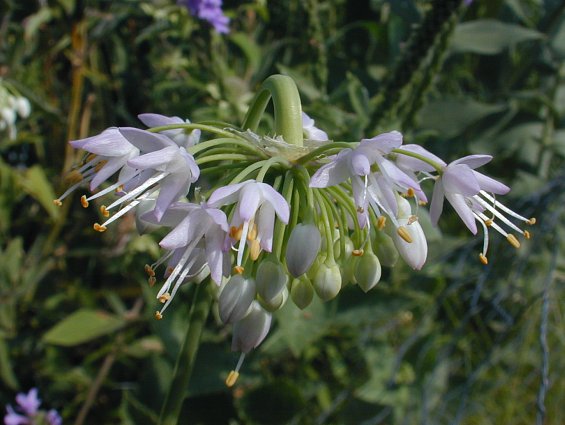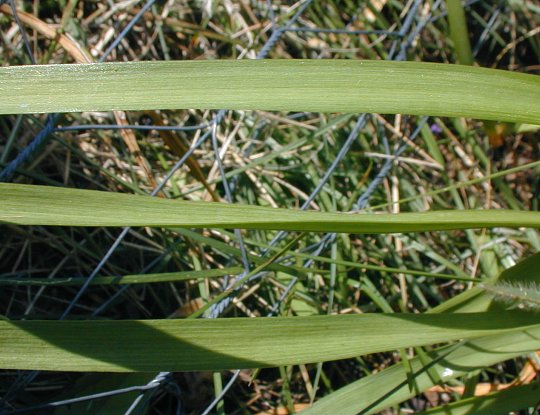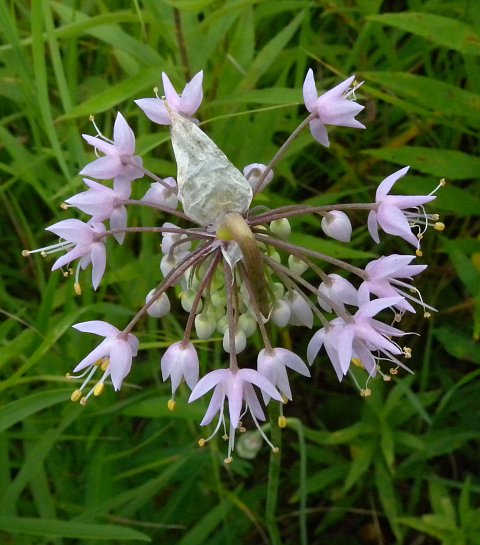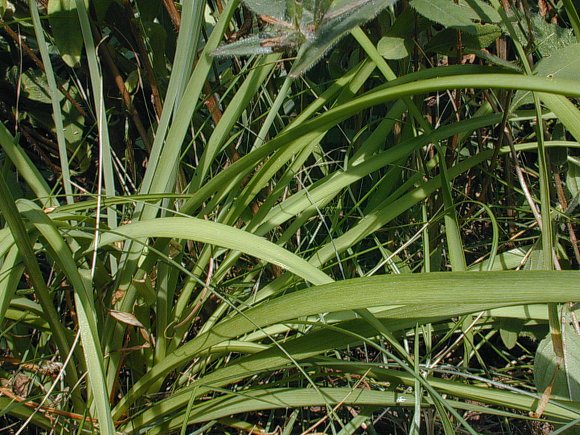Description: This perennial plant consists of a tuft of basal leaves from which one or more flowering stalks emerge. The basal leaves are erect, ascending, or arching; they are up to 12" long and up to 8 mm. across. The basal leaves are linear in shape, medium green, glabrous, and smooth along their margins; they are solid and flattened. Leaf venation is parallel. Each leaf is slightly keeled along its midvein. The flowering stalks are up to 1½' long and more or less erect; they are light green or light reddish purple, glabrous, and terete. Each stalk terminates in a nodding umbel of flowers that emerges from a pair of sack-like membranes; these membranes are deciduous. Each umbel spans about 1½–2" across, consisting of 40-60 pedicellate flowers.

The flowers are individually about ¼" (6 mm.) across, consisting of 6 spreading tepals, 6 exserted stamens, and an ovary with a style. The tepals are white, light lavender, or pink; they are lanceolate in shape. The stamens have white filaments and yellow anthers. The pedicels are ½–1" long; they are light green or light reddish purple, glabrous, and more or less terete. The blooming season usually occurs during mid-summer, lasting 3-4 weeks. There is no noticeable floral scent. Afterwards, the flowers are replaced by seed capsules; each capsule contains several small black seeds that it splits open to release. The root system consists of a bulb that is longer than it is wide. Both the bulb and foliage of this plant have a typical onion-like scent. Clonal offsets are produced, forming new bulbs underground.

Cultivation:
The preference is full to partial sun, moist to mesic
conditions, and soil containing black loam, sand, or rocky material.
While this plant can survive hot dry summers, it does better with more
moisture. Foliar disease is rarely a problem. This plant is easy to
grow under cultivation, and it will spread gradually under suitable
conditions. It is easier to establish plants by transplanting the bulbs
of offsets, rather than by attempting to germinate the seeds.
Range & Habitat:
Nodding Onion is an uncommon plant that occurs only in NE Illinois (see
Distribution
Map), where it is native. Habitats include black
soil prairies, sandy pannes, and thinly wooded bluffs. Much of
the prairie habitat where this plant once occurred has been destroyed
by development. Nodding Onion is normally found in high-quality natural
areas, although it could escape from cultivation into more disturbed
areas.

Faunal Associations: The nectar and pollen of the nodding flowers attract primarily bees, including honeybees, bumblebees, Anthophorine bees (Anthophora spp.), and Halictid bees (Lasioglossum spp.). Insects that feed destructively on the foliage, bulbs, and other parts of Nodding Onion and other onion species (Allium spp.) include the Onion Plant Bug (Lindbergocapsus allii) and a similar plant bug (Lindbergocapsus ainsliei), larvae of the False Japanese Beetle (Strigoderma arbicola), larvae of the Onion Maggot (Delia antiqua), larvae of the Black Onion fly (Tritoxa flava), larvae of the Onion Bulb Fly (Eumerus strigatus), and Onion Thrips (Thrips tabaci). Mammalian herbivores usually avoid Allium spp., although cattle and other livestock may browse on their foliage along with the grass in pastures, causing an off-flavor in their milk.

Photographic
Location:
The photographs were taken at the wildflower garden of the webmaster in
Urbana, Illinois, and at a restored prairie in Meadowbrook Park of the
same city.
Comments:
This plant is easy to identify because of the nodding habit of its
umbels of flowers. Nodding umbels of flowers are an evolutionary
adaptation that tends to restrict insect visitors to bees. Other
insects are more reluctant to hang upside down while attempting to feed
on nectar or pollen. The nodding habit may also protect the nectar from
rain. Compared to 2 other species that are native, the Cliff
Onion (Allium stellatum)
and Wild Garlic (Allium
canadense), Nodding Onion (Allium cernuum) has
wider leaves. Compared to the non-native Field Garlic (Allium vineale),
Chives (Allium
schoenoprasum), and Cultivated Onion (Allium cepa), the
leaves of Nodding Onion are flattened and solid throughout, rather than
hollow.